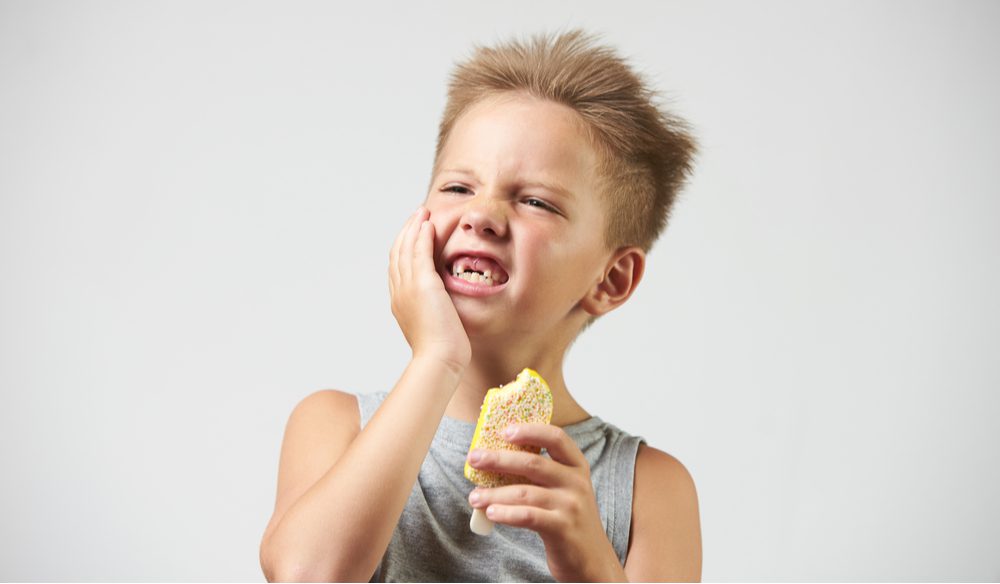When tooth decay erodes through the enamel and dentin, and reaches the inside of the tooth, this is known as a pulp infection, or pulpitis. Pediatric pulp therapy, also known as a baby root canal, pulpotomy, pulpectomy, or nerve treatment, is a restorative dental treatment performed on primary teeth to remove decay from the inside of the tooth in order to prevent the spread of infection and preserve the tooth. There are two types of pulp therapy:
Vital pulp therapy removes only the decayed pulp tissue and preserves the healthy pulp tissue by placing an antibacterial solution inside the tooth. A pediatric dental crown will then be placed over the tooth for protection.
Non-vital pulp therapy removes all the dental pulp from the pulp chamber and root canals. Then, the inside of the tooth is cleaned, filled with a special material, and covered with a pediatric crown. The material used in non-vital pulp therapy temporarily preserves the primary tooth until the material is absorbed by the body to naturally allow the primary tooth to fall out and make space for the permanent tooth.
Did You Know?
The World Health Organization (WHO) notes that 60-90% of school-aged children around the world are affected by dental cavities that require dental treatment.
Frequently Asked Questions:
Does my child need pediatric pulp therapy?
Your child will need pediatric pulp therapy if they have severe tooth decay that has reached the innermost pulp layer. Vital pulp therapy is generally performed when the decay is centralized in one area, while non-vital pulp therapy is performed when the decay has spread through the entire pulp chamber and root canals. While some pulp infections can only be detected through dental x-rays, other infections may cause the following symptoms:
- Persistent and/or progressive tooth pain
- Lingering tooth sensitivity to hot, cold, and sweet foods or beverages
- Swelling or redness in the gums around the affected tooth
Additionally, children with damaged teeth may also need pediatric pulp therapy if the damage has reached the pulp layer. Although your child will eventually lose their primary teeth, pediatric pulp therapy prevents the infection from spreading to the surrounding teeth and preserves the affected tooth to prevent complications that affect the incoming permanent teeth. If your child is experiencing any symptoms of a pulp infection, call Carr Pediatric Dentistry as soon as possible to schedule an appointment.
What is the difference between a baby root canal and an adult root canal?
While baby root canals are somewhat similar to traditional root canals performed on adults, there are a few key differences. For starters, baby root canals do not use permanent fillings on the inside of the tooth in order to allow the tooth to be naturally lost. Another key difference is the fact that baby root canals are more essential than traditional root canals since tooth decay spreads much faster in primary teeth than it does in permanent teeth.
What can my child expect when having pediatric pulp therapy at Carr Pediatric Dentistry?
At Carr Pediatric Dentistry, we do everything that we can to ensure your child has a positive dental experience. When it comes to performing pediatric pulp therapy, your child will be properly anesthetized and sedated to keep them from feeling any pain or anxiety. Once your child is ready, our dentist will begin the procedure by making a small access hole in the top or side of the affected tooth. Next, some or all of the dental pulp will be removed from the inside of the tooth, depending on whether vital or non-vital pulp therapy is being performed.
Then, teeth being treated with vital pulp therapy will have an antibiotic solution placed inside, while those being treated with non-vital pulp therapy will have their entire pulp chamber and root canals thoroughly cleaned. Teeth being treated with non-vital pulp therapy will then be filled with a rubber-like material known as gutta percha to provide temporary support. Finally teeth treated with both vital and nonvital pulp therapy will have a pediatric crown placed.
How do I care for my child after they have pediatric pulp therapy?
After having pediatric pulp therapy, your child may still be groggy, depending on the level of sedation used. It is not uncommon for your child to experience minor discomfort in the days following the procedure. This is usually caused by inflammation from the infection and it can be managed through over the counter pain medications and ice packs. Within a week, your child should be back to their normal routine and diet.

